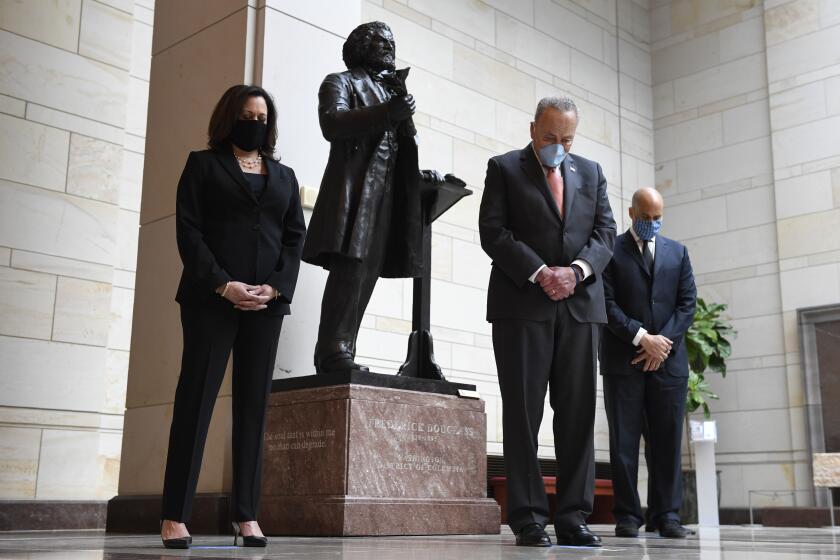Stem Cell Initiative Lacks Oversight
The Now-They-Tell-Us Department, best known for the nonexistent WMDs in Iraq, has a surprise for California voters who approved the $3-billion embryonic stem cell research bond in the last election:
Don’t expect state officials to have much oversight of how the money gets spent.
This realization emerges from a spat that has erupted between two supporters of the program. One is Robert Klein II, the Palo Alto real estate developer who spearheaded the $27-million ballot campaign for Proposition 71 and may become the program’s first chairman. The other is state Sen. Deborah Ortiz, who first proposed a stem cell bond issue back in 2002 (for a measly $1 billion), only to find herself stampeded by Klein and other promoters of the final sky’s-the-limit version.
Ortiz on Monday introduced a bill to correct the shortcomings she found in Klein’s initiative. Her goal is to ensure that Californians get cut-rate access to any cures they have funded through their $6 billion in principal and interest, and that explicit guidelines are established to guarantee the state lands a share of any patent or licensing revenue.
She also wants stringent conflict-of-interest and financial disclosure rules to apply to the 29 appointed members of the board that will run the stem cell program and to all the members of the scientific committees that will review grant applications.
Ortiz’s proposals struck a sour note at a conference on research grant-making that Klein’s committee convened Monday in Irvine. From the podium a rattled Klein alluded to provisions in the initiative that bar any legislative amendments for at least 36 months, and thereafter allow them only by a 70% vote in both houses. “There are very clear prohibitions against legislative intervention,” he said.
Ortiz says there may be some loopholes in the prohibition. But she knows they won’t be easy to exploit. More to the point, she and other supporters of Proposition 71 should have seen these issues coming.
The initiative campaign run by Klein’s committee showed how righteousness can degenerate into self-righteousness; it sold voters on the huge program by all but promising cures for a host of serious diseases without discussing candidly how little is known about when -- or whether -- embryonic stem cell research will yield any therapies.
That’s one reason the program now faces issues of public accountability. Experienced research professionals say it will be crucial to manage the high expectations churned up during the Proposition 71 electoral campaign. “How do you talk to people about incremental scientific progress when they think they were voting for cures?” Susanne Huttner, a research administrator for the UC system, asked at the Irvine meeting.
“One thing that’s absolutely sure is that if this money is properly invested, we’re going to make remarkable strides,” she told me later. But for the stem cell program to reach its goals, it may need public support beyond its 10-year term. That means giving people a better understanding of the complexities and challenges that lie ahead.
Then there are the holes in the program’s fiscal accountability: What guarantees are there that the public interest embodied in Proposition 71 won’t somehow shade into the self-interest of those handing out the money or those receiving it?
The measure’s backers say it requires frequent public audits and reports. And consumer advocacy organizations such as the California Public Interest Research Group vow to keep a close eye on the program.
As one speaker told the Irvine conference this week, “Whatever’s going to be done will be done in a goldfish bowl.”
But for all that, there’s no authority for anyone outside the program board itself to withhold funds or fix problems if things go off the rails; this isn’t a formula for real oversight, but for administrative and political bickering.
When I asked Klein why state officials shouldn’t exercise some supervision, he replied that this would contradict the “people’s will” that the program be independent, as evidenced by its large electoral margin.
Perhaps he’s unaware that very few of the 7 million Californians who voted for Proposition 71 actually read the measure, which runs to about 9,000 words of armor-plated legalese. Certainly his committee spent scarcely a dime of its $27-million war chest distributing copies and explaining its complex provisions.
Anyone who did peruse the text would have learned that the 29-member Independent Citizen’s Oversight Committee, which will have sole authority to spend the bond proceeds, will include representatives of universities, research centers, biomedical companies and disease advocacy groups in line to drink from the state’s capacious new trough -- but not a single elected official.
Although the board members will be barred from voting on grants to their own employers, most will represent such an insular community of academics and entrepreneurs that logrolling of the you-approve-my-grant-and-I’ll-vote-for-yours stripe will be a constant danger.
And though it’s true that the governor, lieutenant governor, treasurer and controller will each name several members to the board, their choices are narrowly specified. Seats earmarked for representatives of eight disease advocacy groups -- spinal cord injuries, Alzheimer’s, diabetes, etc. -- have been doled out to them two apiece, like cards in a blackjack hand.
That means it will be hard for them to appoint effective watchdogs. But somebody is going to have to watch.
“We need to make sure that private companies do not profit unfairly from public money,” says Steven Blackledge, legislative director at CalPIRG. “This could be a boon for medical advancements but a boondoggle for taxpayers.”
Golden State appears every Monday and Thursday. You can reach Michael Hiltzik at golden.state@latimes.com and read his previous columns at latimes.com/hiltzik.
More to Read
Get the L.A. Times Politics newsletter
Deeply reported insights into legislation, politics and policy from Sacramento, Washington and beyond. In your inbox three times per week.
You may occasionally receive promotional content from the Los Angeles Times.











